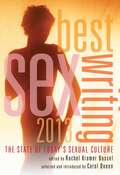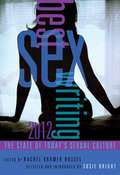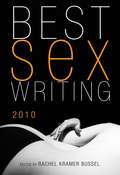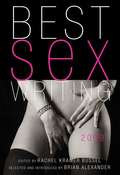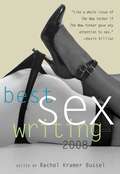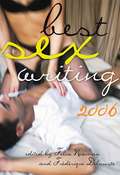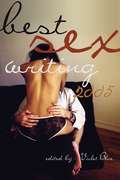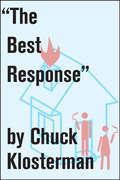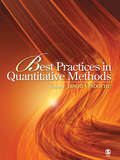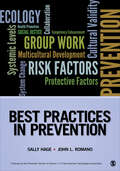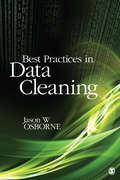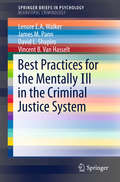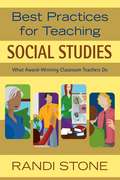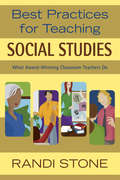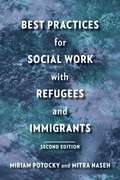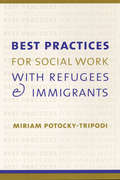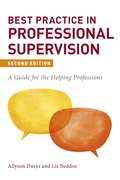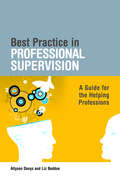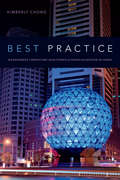- Table View
- List View
Best Sex Writing 2013: The State of Today's Sexual Culture
by Rachel Kramer BusselThe Best Sex Writing series has has fundamentally changed the way people think--and what they say--about sexuality. Once again, Rachel Kramer Bussel has collected the year's most challenging and provocative nonfiction articles on this endlessly evocative subject. The essays here comprise a detailed, direct survey of the contemporary American sexual landscape. Major commentators examine the many roles sex plays in our lives in these literate and lively essays. Judged by the Dr. Carol Queen, who is without peer, this stunning collection of sexsmart essays is sure to stir the heart, the brain, as well as other major organs.
Best Sex Writing 2013
by Rachel Kramer Bussel Carol QueenThe Best Sex Writing series has has fundamentally changed the way people think-and what they say-about sexuality. Once again, Rachel Kramer Bussel has collected the year's most challenging and provocative nonfiction articles on this endlessly evocative subject. The essays here comprise a detailed, direct survey of the contemporary American sexual landscape. Major commentators examine the many roles sex plays in our lives in these literate and lively essays. Judged by the Dr. Carol Queen, who is without peer, this stunning collection of sexsmart essays is sure to stir the heart, the brain, as well as other major organs.
Best Sex Writing 2012
by Susie Bright Rachel Kramer BusselIn Best Sex Writing 2012, editor Rachel Kramer Bussel and judge Susie Bright collect the year's most challenging and provocative nonfiction articles on this endlessly evocative subject. The essays here comprise a detailed, direct survey of the contemporary American sexual landscape. Major commentators examine the many roles sex plays in our lives in these literate and lively essays. From an "X-Rated Jew," a sex blogger's custody battle and teen sex laws to SlutWalks, female pleasure workshops, porn star celebrities, gays in the military, and "guys who like fat chicks," Best Sex Writing 2012 goes behind the headlines to explore the intricacies of sex and aging, sex and the law, and many other hot topics. With a foreword and selections by renowned sexpert Susie Bright, this collection is timely, powerful and provocative, and touches on the most cutting-edge issues facing our culture today.
Best Sex Writing 2012: The State of Today's Sexual Culture
by Rachel Kramer BusselIn Best Sex Writing 2012, editor Rachel Kramer Bussel and judge Susie Bright collect the year's most challenging and provocative nonfiction articles on this endlessly evocative subject. The essays here comprise a detailed, direct survey of the contemporary American sexual landscape. Major commentators examine the many roles sex plays in our lives in these literate and lively essays. From an "X-Rated Jew," a sex blogger's custody battle and teen sex laws to SlutWalks, female pleasure workshops, porn star celebrities, gays in the military, and "guys who like fat chicks," Best Sex Writing 2012 goes behind the headlines to explore the intricacies of sex and aging, sex and the law, and many other hot topics. With a foreword and selections by renowned sexpert Susie Bright, this collection is timely, powerful and provocative, and touches on the most cutting-edge issues facing our culture today.
Best Sex Writing 2010
by Rachel Kramer BusselFrom breastfeeding to swingers to underage sexting, the thinnest condom ever and sex work to the thrill of voyeurism and the story of X-rated Tijuana bibles, Best Sex Writing 2010 covers the latest, hottest topics from the world of sex. Diana Joseph relives her slutty years while giving a mom's perspective on her teenage son's description of girls in his yearbook, while Brian Alexander teaches us about sex surrogates, and Violet Blue offers a spirited defense of modern porn. The erotic elements of Twilight, adult sex ed, a visit to a BDSM porn set, the science behind penis size, a very special piece of ass, a cheating wife, and much more make it under the covers of Best Sex Writing 2010, culled from magazines, newspapers, blogs and websites by series editor Rachel Kramer Bussel.
Best Sex Writing 2010
by Rachel Kramer BusselFrom breastfeeding to swingers to underage sexting, the thinnest condom ever and sex work to the thrill of voyeurism and the story of X-rated Tijuana bibles, Best Sex Writing 2010 covers the latest, hottest topics from the world of sex. Diana Joseph relives her slutty years while giving a mom's perspective on her teenage son's description of girls in his yearbook, while Brian Alexander teaches us about sex surrogates, and Violet Blue offers a spirited defense of modern porn. The erotic elements of Twilight, adult sex ed, a visit to a BDSM porn set, the science behind penis size, a very special piece of ass, a cheating wife, and much more make it under the covers of Best Sex Writing 2010, culled from magazines, newspapers, blogs and websites by series editor Rachel Kramer Bussel.
Best Sex Writing 2009
by Rachel Kramer BusselIntelligent, upbeat, and sex-positive, the pieces in Best Sex Writing 2009 offer an in-depth look at sex the way it actually happens in America today. Gubernatorial sex scandals, rape fantasies, "Dear John" letters, teen sexuality, purity balls, the pregnant man, the science of screwing, bathroom sex, and other topics are scrutinized by noted columnists, bloggers, and authors in pieces that are funny, informative, challenging, sexy, and serious. Edited by sex commentator and erotic author Rachel Kramer Bussel and guest judge MSNBC sex columnist Brian Alexander, this collection goes behind the headlines for a very different kind of sex ed.
Best Sex Writing 2008
by Rachel Kramer BusselCaptures the heart and soul of what's happening behind the bedroom door, where lust, desire, gender, identity, sex work, and politics collide. The best sex journalism of the year in one unforgettable book. Do Jewish girls give better blowjobs? What does it mean to be a modern-day eunuch? Does abstinence-only sex education work? Would you want to work in the pink ghetto or live in the glass closet? How "hung" are African-American men? What happens to a celebrity sex tape star in Iran? Best Sex Writing 2008 answers these questions (and raises many more) as it probes the inner lives of those on the front lines -- political, personal, and cultural -- of lust. From dangerous dildos to professional submissives, the erotic appeal of twins, sex work, pornography and much more, these authors delve into the underbelly of eroticism. Probing stereotypes, truths, and the tricky areas in between, Best Sex Writing 2008 opens the bedroom door and explores the complexity of modern sexuality with thought-provoking, cutting-edge essays and articles.
Best Sex Writing 2006
by Felice NewmanSometimes surprising, always stimulating -- this book offers a snapshot of America's complex sexual practices and mores as seen through Cleis's unique lens. It is the best nonfiction sex journalism of the year in one unforgettable book. In a single generation, Cleis Press has fundamentally changed the way people talk -- and what they read -- about sex and gender. Founded by Felice Newman and Frédérique Delacoste in 1980, the press's mission is to explore and celebrate sex in all its forms, with a decided tilt toward the queer and the subversive. For the first time, Cleis's founders bring their own sex-positive sensibilities to bear on one of their most popular series. In Best Sex Writing 2006, they've collected the year's most challenging and provocative nonfiction articles on this endlessly evocative subject. The essays here comprise a detailed, direct survey of the contemporary American sexual landscape, a landscape Newman and Delacoste helped shape with such ground-breaking books as Sex Work and The Good Vibrations Guide to Sex. Major commentators both in and out of Cleis's stable of writers examine the many roles sex plays in our lives in these literate and lively essays.
Best Sex Writing 2006
by Felice Newman Frédérique DelacosteSometimes surprising, always stimulating - this book offers a snapshot of America's complex sexual practices and mores as seen through Cleis's unique lens. It is the best nonfiction sex journalism of the year in one unforgettable book.In a single generation, Cleis Press has fundamentally changed the way people talk - and what they read - about sex and gender. Founded by Felice Newman and Frédérique Delacoste in 1980, the press's mission is to explore and celebrate sex in all its forms, with a decided tilt toward the queer and the subversive. For the first time, Cleis's founders bring their own sex-positive sensibilities to bear on one of their most popular series. In Best Sex Writing 2006, they've collected the year's most challenging and provocative nonfiction articles on this endlessly evocative subject. The essays here comprise a detailed, direct survey of the contemporary American sexual landscape, a landscape Newman and Delacoste helped shape with such ground-breaking books as Sex Work and The Good Vibrations Guide to Sex. Major commentators both in and out of Cleis's stable of writers examine the many roles sex plays in our lives in these literate and lively essays.
Best Sex Writing 2005
by Violet BlueBest-selling author Violet Blue searched the country and found the most stunning and brave sexual nonfiction writing of the year. Best Sex Writing 2005 includes pieces from more than 20 cutting-edge sex writers, including Michelle Tea, Carol Queen, Annalee Newitz, and Patrick Califia.The author (Ultimate Guide to Fellatio, Ultimate Guide to Cunnlingus, Ultimate Guide to Sexual Fantasy) and erotica editor (Taboo, the Sweet Life series), Violet Blue turns her sights to nonfiction in Best Sex Writing 2005, first in a new series from Cleis Press. With Cleis's trademark sharp, provocative editing and packaging, Best Sex Writing 2005 is destined to become an annual favorite. Best Sex Writing 2005 offers a swirling, multi-colored microcosm of American sexual practices and attitudes. Whether visiting a New York gay sex club, an L.A. escort agency, a Bronx sex ed. class, or a sex workers' enclave south of the border, Violet Blue takes readers on a tour they won't soon forget.
Best Sex Writing 2005
by Violet BlueBest-selling author Violet Blue searched the country and found the most stunning and brave sexual nonfiction writing of the year. Best Sex Writing 2005 includes pieces from more than 20 cutting-edge sex writers, including Michelle Tea, Carol Queen, Annalee Newitz, and Patrick Califia. The author (Ultimate Guide to Fellatio, Ultimate Guide to Cunnlingus, Ultimate Guide to Sexual Fantasy) and erotica editor (Taboo, the Sweet Life series), Violet Blue turns her sights to nonfiction in Best Sex Writing 2005, first in a new series from Cleis Press. With Cleis's trademark sharp, provocative editing and packaging, Best Sex Writing 2005 is destined to become an annual favorite. Best Sex Writing 2005 offers a swirling, multi-colored microcosm of American sexual practices and attitudes. Whether visiting a New York gay sex club, an L.A. escort agency, a Bronx sex ed. class, or a sex workers' enclave south of the border, Violet Blue takes readers on a tour they won't soon forget.
The Best Response
by Chuck KlostermanOriginally collected in Eating the Dinosaur and now available both as a stand-alone essay and in the ebook collection Chuck Klosterman on Living and Society, this essay is about the best response to various situations.
Best Practices in Quantitative Methods
by Jason W. OsborneThe contributors to Best Practices in Quantitative Methods envision quantitative methods in the 21st century, identify the best practices, and, where possible, demonstrate the superiority of their recommendations empirically. Editor Jason W. Osborne designed this book with the goal of providing readers with the most effective, evidence-based, modern quantitative methods and quantitative data analysis across the social and behavioral sciences.The text is divided into five main sections covering select best practices in Measurement, Research Design, Basics of Data Analysis, Quantitative Methods, and Advanced Quantitative Methods. Each chapter contains a current and expansive review of the literature, a case for best practices in terms of method, outcomes, inferences, etc., and broad-ranging examples along with any empirical evidence to show why certain techniques are better.Key Features: Describes important implicit knowledge to readers: The chapters in this volume explain the important details of seemingly mundane aspects of quantitative research, making them accessible to readers and demonstrating why it is important to pay attention to these details. Compares and contrasts analytic techniques: The book examines instances where there are multiple options for doing things, and make recommendations as to what is the "best" choice—or choices, as what is best often depends on the circumstances.Offers new procedures to update and explicate traditional techniques: The featured scholars present and explain new options for data analysis, discussing the advantages and disadvantages of the new procedures in depth, describing how to perform them, and demonstrating their use.Intended Audience: Representing the vanguard of research methods for the 21st century, this book is an invaluable resource for graduate students and researchers who want a comprehensive, authoritative resource for practical and sound advice from leading experts in quantitative methods.
Best Practices in Prevention (Prevention Practice Kit)
by Hage, Sally and Romano, John L.This second book in the Prevention Practice Kit provides counselors, psychologists, and other mental health workers with practical steps that need to be considered by prevention practitioners as they engage with others in developing and delivering prevention projects. A context for engaging in prevention practice is provided, including discussion of how prevention fits with traditional models of psychology, descriptions of theoretical models for doing prevention practice, and examples of empirically-supported prevention interventions.The reader will learn about a new set of Prevention Guidelines being proposed to the American Psychological Association, and why these recommendations are important to consider. The book highlights the essential aspects of collaboration, cultural relevance, social justice, and program dissemination, and addresses knotty ethical issues surrounding confidentiality in prevention and health promotion efforts. In addition, the book provides information on funding and readily available resources for prevention. Finally, examples and activities are provided throughout the book—accompanied by a set of learning exercises—to help readers apply what they learn.This book is part of the Prevention Practice Kit: Action Guides for Mental Health, a collection of eight books each authored by scholars in the specific field of prevention and edited by Dr. Robert K. Conyne and Dr. Arthur M. Horne. The books in the collection conform to the editors′ outline to promote a consistent reading experience. Designed to provide human services practitioners, counselors, psychologists, social workers, instructors, and students with concrete direction for spreading and improving the practice of prevention, the series provides thorough coverage of prevention application including a general overview of prevention, best practices, diversity and cultural relevance, psychoeducational groups, consultation, program development and evaluation, evidence base, and public policy.This book is endorsed by the Prevention Section of the Society of Counseling Psychology of the American Psychological Association. Fifty percent of all royalties are donated to Division 17 of the APA.
Best Practices in Data Cleaning: A Complete Guide to Everything You Need to Do Before and After Collecting Your Data
by Jason W. OsborneMany researchers jump from data collection directly into testing hypothesis without realizing these tests can go profoundly wrong without clean data. This book provides a clear, accessible, step-by-step process of important best practices in preparing for data collection, testing assumptions, and examining and cleaning data in order to decrease error rates and increase both the power and replicability of results.Jason W. Osborne, author of the handbook Best Practices in Quantitative Methods (SAGE, 2008) provides easily-implemented suggestions that are evidence-based and will motivate change in practice by empirically demonstrating—for each topic—the benefits of following best practices and the potential consequences of not following these guidelines.
Best Practices in Assessment of Research and Development Organizations
by Panel for Review of Best Practices in Assessment of Research Development OrganizationsResearch and development (R&D) organizations are operated by government, business, academe, and independent institutes. The success of their parent organizations is closely tied to the success of these R&D organizations. In this report, organizations refers to an organization that performs research and/or development activities (often a laboratory), and parent refers to the superordinate organization of which the R&D organization is a part. When the organization under discussion is formally labeled a laboratory, it is referred to as such. The question arises: How does one know whether an organization and its programs are achieving excellence in the best interests of its parent? Does the organization have an appropriate research staff, facilities, and equipment? Is it doing the right things at high levels of quality, relevance, and timeliness? Does it lead to successful new concepts, products, or processes that support the interests of its parent? This report offers assessment guidelines for senior management of organizations and of their parents. The report lists the major principles of assessment, noting that details will vary from one organization to another. It provides sufficient information to inform the design of assessments, but it does not prescribe precisely how to perform them, because different techniques are needed for different types of organizations. Best Practices in Assessment of Research and Development Organizations covers three key factors that underpin the success of an R&D organization: (1) the mission of the organization and its alignment with that of the parents; (2) the relevance and impact of the organization's work; and (3) the resources provided to the organization, beginning with a high-quality staff and management.
Best Practices for the Mentally Ill in the Criminal Justice System (SpringerBriefs in Psychology)
by Vincent B. Van Hasselt David L. Shapiro Lenore E.A. Walker James M. PannThis timely brief resource introduces a new evidence-based model for treatment of mentally ill individuals in jails, with emphasis on community-based options. Forensic mental health experts review police alternatives to arresting mentally ill persons in confrontations, the efficacy of problem-solving courts, and continuity of care between jail and community. The book's best-practices approach extends to frequently related issues such as addiction, domestic violence, juvenile considerations, and trauma and describes successful programs coordinating judicial and clinical systems. These guidelines for decriminalizing non-violent behaviors and making appropriate services available to those with mental problems should also help address issues affecting the justice system, such as overcrowding. Included in the coverage: The Best Practices Model. Best practices in law enforcement crisis interventions with the mentally ill. Problem-solving courts and therapeutic jurisprudence. Competency restoration programs. A review of best practices for the treatment of persons with mental illness in jail. Conclusions, recommendations, and helpful appendices. With its practical vision for systemic improvement, Best Practices Model for Intervention with the Mentally Ill in the Criminal Justice System is progressive reading for practitioners in the mental health field, especially practitioners working with inmates, as well as for stakeholders in the law enforcement and justice systems.
Best Practices for Teaching Social Studies: What Award-Winning Classroom Teachers Do
by Randi StoneRandi Stone transports readers into the lively classrooms of award-winning teachers in this collection of outstanding methods for teaching social studies to diverse elementary, middle, and high school learners. Like its companion volumes for teaching writing, mathematics, and science, Best Practices for Teaching Social Studies presents firsthand accounts from educators offering fresh ideas and inquiry-based techniques to build student confidence, increase academic achievement, and develop critical thinking skills. Highlights include master teachers' tips on how to: Organize and produce oral history projects Use technology to explore diversity Teach the art of geography and the geography of art Put the "social" back into social studies, and more! Beginning and experienced teachers alike will discover an abundance of creative teaching practices to strengthen the social studies curriculum.
Best Practices for Teaching Social Studies: What Award-Winning Classroom Teachers Do
by Randi B. StoneThis collection of outstanding, teacher-tested methods for K–12 social studies instruction for diverse classrooms offers fresh ideas and strategies covering citizenship, diversity, community, and more.
Best Practices for Social Work with Refugees and Immigrants
by Miriam Potocky Mitra NasehSocial work practice with refugees and immigrants requires specialized knowledge of these populations and specialized adaptations and applications of mainstream services and interventions. Because they are often confronted with cultural, linguistic, political, and socioeconomic barriers, these groups are especially vulnerable to psychological problems such as anxiety, depression, alienation, grief, and post-traumatic stress disorder, as well as concerns arising from inadequate health care. Institutionalized discrimination and anti-immigrant policies and attitudes only exacerbate these challenges.The second edition of Best Practices for Social Work with Refugees and Immigrants offers an update to this comprehensive guide to social work with foreign-born clients and an evaluation of various helping strategies and their methodological strengths and weaknesses. Part 1 sets forth the context for evidence-based service approaches for such clients by describing the nature of these populations, relevant policies designed to assist them, service-delivery systems, and culturally competent practice. Part 2 addresses specific problem areas common to refugees and immigrants and evaluates a variety of assessment and intervention techniques in each area. Using a rigorous evidence-based and pancultural approach, Miriam Potocky and Mitra Naseh identify best practices at the macro, meso, and micro levels to meet the pressing needs of uprooted peoples. The new edition incorporates the latest research on contemporary social work practice with refugees and immigrants to provide a practical, up-to-date resource for the multitude of issues and interventions for these populations.
Best Practices for Social Work with Refugees and Immigrants
by Potocky-Tripodi MiriamRather than focusing on specific groups, this book takes a "pancultural" perspective that focuses on the common experiences of refugees and immigrants. The author focuses on empirically-based practice approaches; assessment and intervention techniques that have been scientifically validated. Based on this approach the book presents the "best practice" for each problem area.
Best Practice in Professional Supervision, Second Edition: A Guide for the Helping Professions
by Liz Beddoe Allyson DavysThis second edition of Best Practice in Professional Supervision is a fully updated and revised guide to being an excellent supervisor in the social care, nursing, counselling and allied health professions. This field has developed rapidly in the past 10 years, and this new edition contains essential updates reflecting the very latest research and practice. The book covers basic skills, the practicalities of forming and maintaining the supervision relationship, and the organisational context and culture of supervision. Viewing supervision as a place for learning, the book also considers how supervision can help practitioners to develop professional resilience and promote their own wellbeing despite the stresses of complex work environments. It also includes specific chapters on supervision of clinical student placements, and in child protection settings. Full of clinical case vignettes illustrating good practice, this is an essential guide for all those undertaking supervision, or supervision training.
Best Practice in Professional Supervision
by Liz Beddoe Allyson DavysBest Practice in Professional Supervision is an authoritative guide to being an excellent supervisor, covering the role, functions and dispositions involved. The authors consider basic skills, the practicalities of forming and maintaining the supervision relationship, and the organisational context and culture of supervision. The book offers practical examples and a model of supervision which draws together ideas from adult learning theory and reflective practice. Viewing supervision as a place for learning, this guide considers how supervision can assist practitioners to develop professional resilience and manage the stresses of complex work environments. It also includes specific chapters on supervision of clinical student placements and in child protection settings. This book covers a range of professions including social care, nursing, counselling, social work and allied health professions, and is an essential guide for all those in these and related professions undertaking supervision or supervision training.
Best Practice: Management Consulting and the Ethics of Financialization in China
by Kimberly ChongIn Best Practice Kimberly Chong provides an ethnography of a global management consultancy that has been hired by Chinese companies, including Chinese state-owned enterprises. She shows how consulting emerges as a crucial site for considering how corporate organization, employee performance, business ethics, and labor have been transformed under financialization. To date financialization has been examined using top-down approaches that portray the rise of finance as a new logic of economic accumulation. Best Practice, by contrast, focuses on the everyday practices and narratives through which companies become financialized. Effective management consultants, Chong finds, incorporate local workplace norms and assert their expertise in the particular terms of China's national project of modernization, while at the same time framing their work in terms of global “best practices.” Providing insight into how global management consultancies refashion Chinese state-owned enterprises in preparation for stock market flotation, Chong demonstrates both the dynamic, fragmented character of financialization and the ways in which Chinese state capitalism enables this process.
